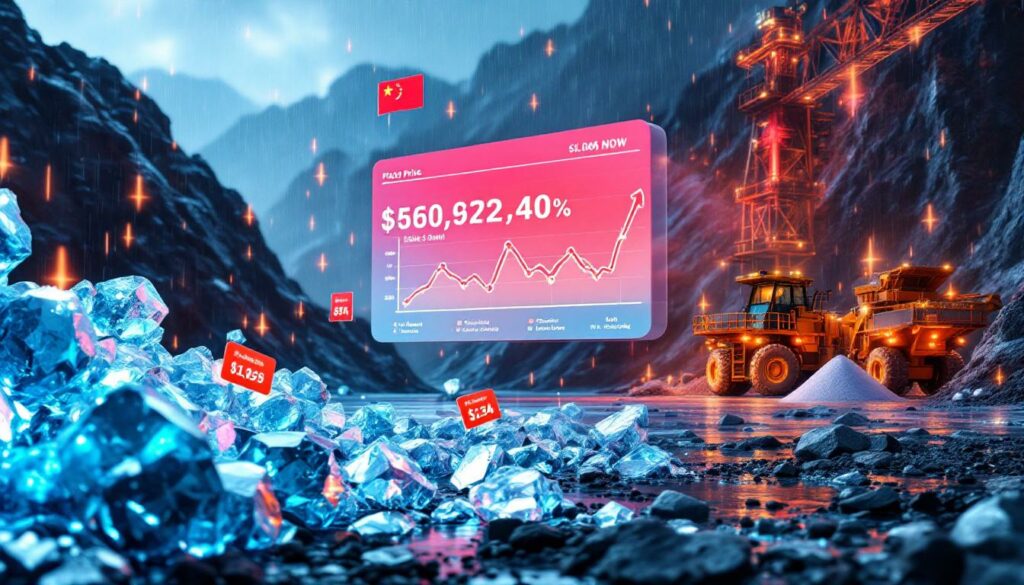What's Happening in the Silica Market?
The silica market is currently experiencing significant pressures as we move through mid-2025, with supply-demand imbalances creating challenging conditions for producers across China's major mining regions.
Current Price Pressures and Supply Conditions
Mine-mouth inventories have reached concerning levels across China's primary silica producing regions, creating a ripple effect throughout the supply chain. This inventory buildup has forced numerous producers to implement production cutbacks, with some facilities in Inner Mongolia and Jiangxi temporarily suspending operations altogether to manage growing stockpiles.
Regional price variations tell an important story about market volatility strategies and dynamics:
- Inner Mongolia high-grade silica: ¥300-340 per metric ton
- Inner Mongolia low-grade silica: ¥320-350 per metric ton
- Jiangxi high-grade silica: ¥380-420 per metric ton
- Jiangxi low-grade silica: ¥310-330 per metric ton
These price points reflect ongoing pressure, with the higher premiums for Jiangxi high-grade materials highlighting quality differentiation even in a challenged market environment.
Factors Driving Weak Demand
Several key factors are contributing to the current demand weakness:
- Seasonal production adjustments: The rainy season in southwest China has triggered reduced silicon plant operations, a regular but significant seasonal disruption
- Widespread operational slowdowns: Even in regions unaffected by seasonal weather, silicon producers are maintaining low operating rates due to broader market conditions
- Tactical purchasing behavior: As noted by Shanghai Metal Market (SMM) analysts, "Purchases were mainly driven by immediate needs, and downstream enterprises had a strong sentiment to drive down prices"
- Buyer leverage: Market conditions have shifted negotiating power to downstream buyers, who are aggressively pursuing price concessions
This combination of factors has created what industry observers describe as a "buyer's market" for silica, with suppliers competing intensely for limited orders.
How Is the Silicon Coal Market Performing?
The silicon coal market presents a nuanced picture in 2025, with performance varying significantly by producer type, geography, and product specification.
Regional Price Differentiation Analysis
Current market conditions reveal important regional price benchmarks that highlight the diversity across China's silicon coal landscape:
- Gansu province: ¥840/mt for mixed coal, ¥960/mt for premium granular coal
- Ningxia region: ¥900/mt for mixed coal, ¥1,140/mt for granular coal
- Xinjiang area: ¥710/mt for non-caking silicon coal, ¥1,250/mt for higher-quality caking silicon coal
These figures demonstrate the substantial price differentials based on both location and quality specifications, with premium products maintaining relative stability despite broader market pressures.
Industry analysis from SMM highlights that "manufacturers in regions where silicon coal is the main product were affected by inventory pressure, leading to a slight downward shift in actual transaction prices." This trend points to differentiated impacts based on producer specialization.
Profitability Challenges for Producers
The current market environment has created a notable dichotomy between different types of producers:
- Specialized silicon coal producers are experiencing significant margin erosion due to inventory pressure and price compression
- Diversified manufacturers with broader product portfolios have demonstrated greater resilience against price fluctuations
- Product quality differentiation has become increasingly important, with higher-specification materials like Xinjiang's caking silicon coal maintaining stronger pricing power
The geological characteristics of coal deposits, particularly factors like ash content, volatile matter percentage, and fixed carbon ratios, are proving crucial determinants of price stability. Producers with access to premium-grade deposits are weathering current market conditions more effectively than those limited to standard-grade resources.
What's Trending in the Electrode Market?
The electrode market is experiencing a period of stagnation characterized by persistent supply-demand imbalances and pricing challenges.
Supply-Demand Imbalance
Current market indicators reveal several key trends:
- Electrode manufacturers continue operating at notably low capacity utilization rates
- Inventory management has become the primary strategic focus for producers, with destocking efforts taking precedence over production maximization
- Shipment velocities remain sluggish, with cautious purchasing behaviors from downstream silicon metal producers limiting market momentum
- SMM analysts note that "despite raw material cost increases, electrode manufacturers found it difficult to raise prices due to weak demand"
This combination of factors has created a market environment where even cost-justified price increases face significant resistance from buyers.
Price Dynamics and Cost Pressures
Current pricing benchmarks across electrode categories illustrate the market's compressed state:
- Ordinary power carbon electrodes (960-1100mm): ¥6,100-6,300/mt
- Ordinary power carbon electrodes (1272mm): ¥6,800-7,000/mt
- Ordinary power graphite electrodes (960-1100mm): ¥9,300-9,500/mt
- Ordinary power graphite electrodes (1272mm): ¥10,900-11,100/mt
These price points remain relatively static despite upstream cost pressures, particularly from petroleum coke inputs. The market is experiencing what SMM describes as "a tug-of-war between expected cost-driven price increases and the reality of weak demand."
Technical considerations around electrode quality—specifically electrical resistivity, thermal expansion coefficients, and mechanical strength—continue to influence pricing tiers, though overall market weakness has compressed traditional premiums.
Market Outlook Assessment
Industry analysts anticipate continued market stagnation in the near term, with several factors shaping the outlook:
- Raw material cost increases (particularly petroleum coke) will maintain pressure on producer margins
- Weak downstream demand from silicon producers will likely persist through the current seasonal cycle
- Cautious purchasing behaviors are expected to limit market momentum
- Inventory management will remain the primary focus for both producers and buyers
Market Insight: The electrode market's inability to pass through rising raw material costs represents a fundamental shift from historical patterns, where cost increases typically translated to price adjustments. This suggests a structural change in market dynamics that may persist beyond current seasonal factors.
How Is the Petroleum Coke Market Evolving?
The petroleum coke market is experiencing a transitional phase, with recent oil price rally insights showing signs of moderation after a period of consistent increases.
Price Trend Analysis
Recent market data reveals an inflection point in the petroleum coke pricing trajectory:
- Local refinery petroleum coke averaged ¥2,327/mt, representing a minimal 0.33% month-over-month increase
- Formosa Plastics petroleum coke traded in the ¥950-1,000/mt range, with noticeably weakening transaction performance
- The significantly reduced momentum in price increases suggests a market approaching equilibrium after previous upward trends
This slowing price growth comes despite ongoing production cost pressures, indicating shifting demand fundamentals are beginning to counterbalance supply-side factors.
Demand Cooling Indicators
Several key indicators point to cooling demand conditions:
- Purchasing enthusiasm from downstream enterprises has diminished significantly
- Refinery shipment rhythms have noticeably slowed, reflecting reduced buyer urgency
- Order sizes have trended smaller as buyers adopt more cautious inventory management approaches
- The previously strong seller's market has begun transitioning toward more balanced conditions
SMM analysts project that "petroleum coke prices will be generally stable with slight fall next week," reflecting this shifting market sentiment.
Quality considerations—particularly sulfur content, volatile matter percentage, and real density—continue to influence pricing tiers, though overall market weakness has begun to compress traditional quality-based premiums.
What Factors Are Influencing the Silicon Metal Raw Materials Market?
The silica and silicon coal market trends are being shaped by a complex interplay of seasonal, operational, and financial factors in 2025.
Weather and Seasonal Impacts
Seasonal weather patterns are playing a significant role in current market dynamics:
- The rainy season in southwest China has triggered widespread production adjustments among silicon plants
- Increased rainfall has affected not only operations but also transportation logistics, creating additional supply chain complexities
- Regional operating rate disparities have emerged, with facilities in weather-affected areas showing markedly lower utilization than those in stable regions
- These weather impacts have created uneven demand patterns across different raw material categories
These seasonal effects have amplified existing market challenges, particularly for suppliers heavily dependent on southwest China's silicon production ecosystem.
Cost-Price Relationship Dynamics
A fundamental disconnect has emerged between raw material costs and finished product pricing:
- Rising input costs for key materials like petroleum coke have failed to translate into corresponding silicon metal price increases
- This price-cost squeeze has created margin pressure throughout the value chain
- Inventory management has become the central strategic priority for both suppliers and producers
- SMM notes that "raw material price increases are struggling to translate to finished product pricing," creating sustainability challenges for upstream suppliers
This cost-price disconnect represents a significant shift from historical market patterns, where input cost increases typically flowed through to finished product pricing.
Purchasing Behavior Shifts
Market participants have adapted their procurement strategies in response to current conditions:
- Just-in-time procurement has become the dominant approach, with buyers minimizing inventory commitments
- Price negotiation leverage has shifted decisively toward buyers in the current oversupplied environment
- Order sizes have trended smaller as buyers prioritize flexibility over volume-based discounts
- Contract durations have shortened, reflecting heightened uncertainty about future market directions
These behavioral shifts represent meaningful changes to established market practices and signal a fundamental reassessment of inventory risk across the silicon metal value chain.
FAQ: Silicon Metal Raw Materials Market
What is causing the current pressure on silica prices?
The silica market is experiencing significant downward price pressure due to multiple converging factors. Mine-mouth inventories have accumulated substantially, creating a fundamental oversupply situation. This inventory buildup has forced producers in key regions like Inner Mongolia and Jiangxi to implement production cutbacks or temporary suspensions.
Simultaneously, demand has weakened considerably due to reduced silicon plant operations during southwest China's rainy season and persistently low operating rates across other silicon-producing regions. This supply-demand imbalance has shifted market power to buyers, who are now engaging in aggressive price negotiations and predominantly need-based purchasing behavior.
Market Context: Silica price pressure is particularly pronounced for lower-grade materials, where product differentiation is minimal. High-grade silica from Jiangxi continues commanding relative premiums due to its superior silicon dioxide content and lower impurity levels.
How are different regions' silicon coal markets performing?
The silicon coal market is experiencing significant regional differentiation in 2025. Producers specializing primarily in silicon coal are facing substantial inventory pressure and price declines. This is particularly evident in regions where silicon coal represents the dominant product offering.
In contrast, diversified manufacturers with broader product portfolios are maintaining more stable pricing power. Current price benchmarks reflect these regional differences:
- Gansu province: ¥840/mt for mixed coal, ¥960/mt for granular coal
- Ningxia region: ¥900/mt for mixed coal, ¥1,140/mt for granular coal
- Xinjiang area: ¥710/mt for non-caking silicon coal, ¥1,250/mt for caking silicon coal
These variations reflect not only regional supply-demand dynamics but also quality differences, with premium specifications like Xinjiang's caking silicon coal maintaining stronger pricing despite broader market pressures.
Why is the electrode market stagnant despite rising raw material costs?
The electrode market is experiencing a fundamental disconnect between input costs and market prices. Despite rising costs for key raw materials like petroleum coke, electrode manufacturers have been unable to pass these increases through to customers due to persistently weak demand from silicon producers.
This market is caught in what industry analysts describe as "a tug-of-war between expected cost-driven price increases and the reality of weak demand." The low operating rates of silicon plants, combined with cautious purchasing behavior from downstream enterprises, have created a market environment where cost-justified price increases face significant buyer resistance.
Electrode manufacturers have responded by prioritizing inventory management over production maximization, with many facilities operating at reduced capacity to avoid further stockpile growth. This situation has created significant margin pressure for producers, particularly those without diversified product portfolios.
What's the outlook for petroleum coke prices in the near term?
After a period of consistent increases, the petroleum coke market is showing clear signs of stabilization with potential modest declines ahead. Local refinery petroleum coke prices have increased by just 0.33% month-over-month to ¥2,327/mt, indicating significantly reduced momentum compared to previous periods.
Several indicators point to cooling market conditions:
- Purchasing enthusiasm from downstream enterprises has diminished noticeably
- Refinery shipment rates have slowed
- Order sizes have trended smaller as buyers adopt more cautious inventory approaches
SMM analysts project that "petroleum coke prices will be generally stable with slight fall next week," reflecting the market's transition from a growth phase to a more balanced or slightly declining trajectory.
How are seasonal factors affecting the silicon metal raw materials market?
Seasonal factors, particularly the rainy season in southwest China, are playing a significant role in shaping current market dynamics. This weather pattern has led to reduced silicon plant operations across a key production region, creating a seasonal demand weakness for raw materials including silica, silicon coal, and electrodes.
The timing of this seasonal disruption is particularly significant as it coincides with inventory pressures across the supply chain. This combination has amplified market challenges, leading to more cautious purchasing behavior and intensified price negotiations.
Beyond direct operational impacts, the rainy season has also affected transportation logistics, creating additional complexities for suppliers attempting to move materials to facilities still operating at normal rates. These seasonal effects have contributed to the uneven demand patterns currently observed across different raw material categories and regions.
Market Data: Silicon Metal Raw Materials Price Comparison
| Raw Material | Region/Specification | Current Price (¥/mt) | Market Trend |
|---|---|---|---|
| Silica (High-grade) | Inner Mongolia | 300-340 | Downward pressure |
| Silica (Low-grade) | Inner Mongolia | 320-350 | Downward pressure |
| Silica (High-grade) | Jiangxi | 380-420 | Downward pressure |
| Silica (Low-grade) | Jiangxi | 310-330 | Downward pressure |
| Silicon Mixed Coal | Gansu | 840 | Differentiated |
| Silicon Granular Coal | Gansu | 960 | Differentiated |
| Silicon Mixed Coal | Ningxia | 900 | Relatively stable |
| Silicon Granular Coal | Ningxia | 1,140 | Relatively stable |
| Non-caking Silicon Coal | Xinjiang | 710 | Differentiated |
| Caking Silicon Coal | Xinjiang | 1,250 | Relatively stable |
| Petroleum Coke | Local Refineries | 2,327 | Slowing increase |
| Petroleum Coke | Formosa Plastics | 950-1,000 | Weakening |
| Power Carbon Electrodes (960-1100mm) | Standard | 6,100-6,300 | Stagnant |
| Power Carbon Electrodes (1272mm) | Standard | 6,800-7,000 | Stagnant |
| Power Graphite Electrodes (960-1100mm) | Standard | 9,300-9,500 | Stagnant |
| Power Graphite Electrodes (1272mm) | Standard | 10,900-11,100 | Stagnant |
Disclaimer: Market prices and trends are based on data from Shanghai Metal Market (SMM) as of July 2025. Prices are subject to change based on market conditions, and readers should consult current reports before making business decisions. The tariff market impacts and industry evolution trends alongside China demand prospects may all influence future market directions.
Looking for Strategic Investments in Mineral Markets?
Discover significant opportunities in the commodities market before they make headlines with Discovery Alert's proprietary Discovery IQ model, which provides real-time notifications on major ASX mineral discoveries and translates complex data into actionable insights. Visit the Discovery Alert discoveries page to understand how early identification of mineral opportunities can generate substantial returns for your investment portfolio.




